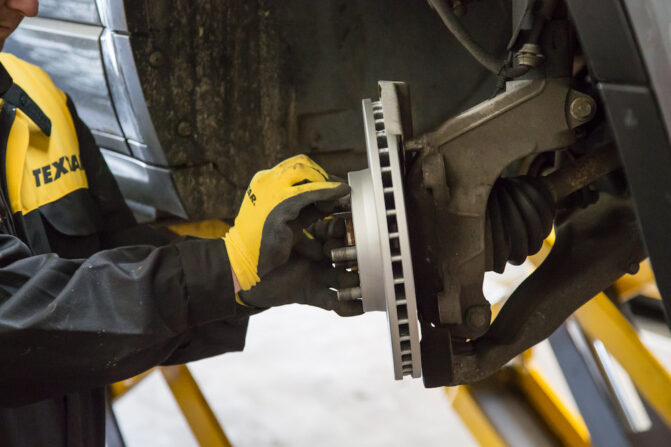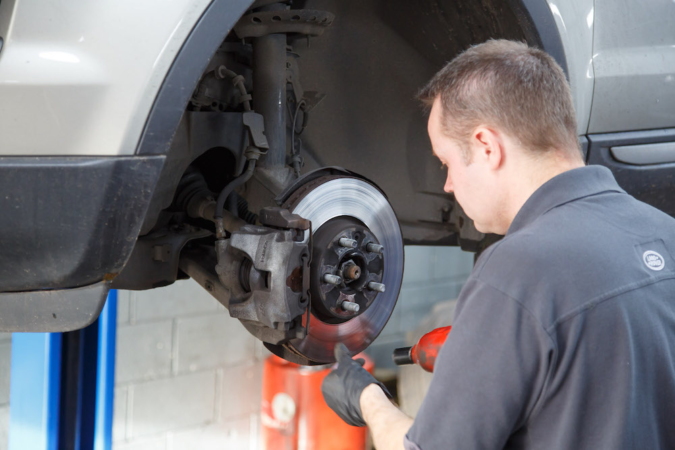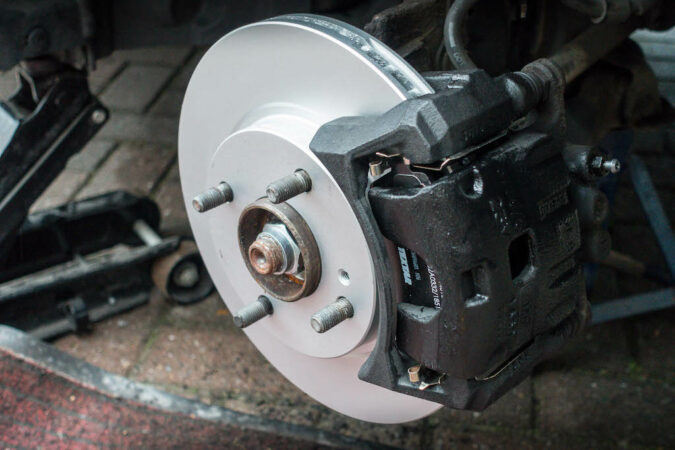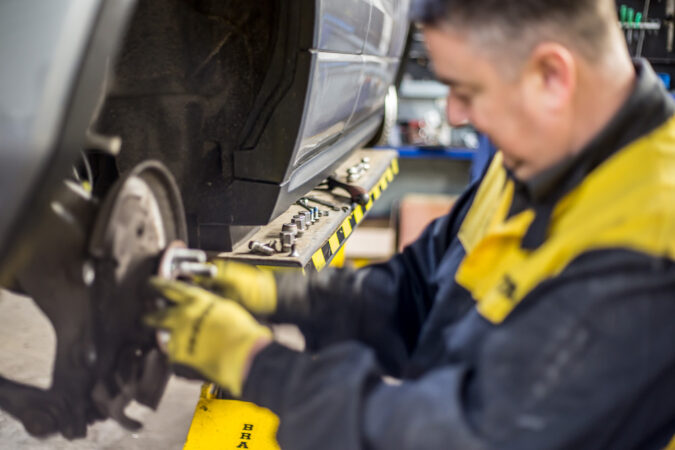What is common in all front-wheel vehicles? A CV joint that’s what! This is a special component located around the front wheels at the end of the drive shaft. If it’s faulty, it results in CV joint noise.
In this post, we are going to look at what causes CV joint noise, what causes a bad CV joint, and how to fix the problem.
The Role Of The CV Joint
Otherwise known as a constant velocity joint, its primary role in your vehicle is to transfer power from the differential and the transmission to the wheels.
The CV joint is therefore a crucial part of your vehicle as it helps it move forward. It can also be expensive to replace once damaged. Therefore it is best to watch out for early signals of potential problems and to fix these fast.
Furthermore, the CV joint is also an important part of the suspension system. One of its key roles is to ensure a smooth and comfortable ride.
But what happens when there is a mechanical or technical issue with your CV joint system? Well, one of the more common tell tales signs is CV joint noise when driving straight. Often you will hear the noise when you are making a turn but can also happen when y0u are driving straight.
Bad CV Joint Noise
Assume you are driving your beloved car only to hear certain noises coming from the CV joint. For instance, CV joint noise when accelerating would imply that you have a faulty CV joint.
Note however that this is not to say that the CV joint cannot be repaired. There are plenty of factors that could cause your CV joint to produce a squeaky sound when driving.
These are:
1. Damaged CV boots
If the CV boots are cracked or torn or have sustained damage, this will cause bad CV joint noise. Damaged boots may result in the grease in the boots leaking out and allowing dirt to accumulate.
As a result, there is friction not just from the dirt but also from the lack of lubrication. Consequently, the CV joint wears out faster and in the worst circumstances may be damaged beyond repair. At this point, you would need to change your CV joint.
If after inspecting your CV joint you notice grease leaking out, this is a clear indication that the CV joint boot is cracked. You will often see grease on the interior surface of your rims.
You may also notice grease on the driven wheel. At this point, the damage is quite advanced and you will hear CV joint noise when accelerating.
Furthermore, due to the rotating motion of the CV axle, the grease may also access other parts of the vehicle such as the chassis. The combination of all these factors will cause bad CV joint noise.
This noise gets louder the faster you drive. However, keep in mind that the more you drive with a damaged CV joint, the more the damage is caused to the CV joint.
2. Faulty Boot Clamps
So we’ve looked at the CV boots, but do you want to know what holds them in place? CV boot clamps! These clamps help seal off the CV boots and ensure that they are not exposed to the CV joint.
If the CV clamps sustained damage, they would not do their job. They would then cause the bolts to loosen up which will allow debris and dirt into the CV joint.
This will in turn cause gunk into the CV joint that will create friction and then cause bad CV joint noise. Therefore, if you heard squeaky or clunking noises, or CV joint noise when accelerating, the first place to always look is the boot areas and inspect the CV boot clamps.
3. A Lack Of Proper Lubrication
Without proper lubrication of your CV joint, there will be friction with the CV axle preventing it from rotating smoothly and freely. Whenever the axle begins to turn, it will cause noises as a result of the friction.
One way to know that your CV joints lack lubrication is that they start to produce a squeaky sound as soon as you begin to drive. The bad CV noise gets louder the faster you drive.
4. CV Joint Noise Due To Age
The natural process of wear and tear will eventually cause damage to your CV joints resulting in CV joint noise while driving. At this point the joints need replacement. This is by no fault of the driver and is entirely normal.
After all, mechanical components will wear out with time and require replacement. Granted, CV joints are some of the more durable components in your car but sooner or later they will also require replacement.
CV Joint Noise When Driving Straight
It is dangerous to drive with a damaged CV joint. This is why it is critical to fix the problem as soon as you discover that you have faulty CV joints. After reading the above section of this post, you will be able to identify a faulty CV joint from CV joint noise when turning or going straight.
The best part is that you will be able to do this early which will help you fix the problem quickly and save on costs.
Bad CV joint noise when driving straight will very often be caused by damaged boots These in turn cause damage to the CV joint.
By performing an inspection, you can notice early any damage to the CV joint boot and rectify this by replacing the boot or clamps and using a quality lubricant before it causes any major damage to the CV joint.
Noticing the problem early through CV joint noise when driving straight has one major advantage. The CV joint replacement cost is quite high but replacing CV joint boots is much cheaper. Even better the CV joint boots also often come with new clamps.
Speaking of the CV joint, it is often not possible to repair individual CV joints. You will need to replace the entire driveshaft which further raises the CV joint replacement cost.
It is not difficult to repair the CV joint boots. Our guide can help you save on labor costs. However, if you feel you lack confidence, you can hire the services of a qualified mechanic. This will add to the costs.
CV Joint Noise When Turning
You may experience bad CV joint noise when turning especially whenever you are turning the steering wheel. Sometimes the car makes noise when turning right but not left. Very often this manifests in the form of clicking or popping sounds.
It is a tell-tale sign that you have a worn-out CV joint or the CV joint is already broken.
There are also a couple of ways that you can test a damaged CV joint. One way is to put the gear in reverse and turn the wheels to one side by turning the steering wheel fully.
When you step on the gas the car will move backward in circles. It is important to ensure that you have the area cleared out to ensure no accidents.
You will begin to notice that the CV joint noise when the turning gets louder and louder. At this point, you will have no choice but to replace the entire driveshaft or CV joint.
Such kind of CV joint noise when turning can be indicative of a disaster waiting to happen as sometimes the whole CV joint can damage to the point of disintegration. This can cause the whole system to collapse and result in an accident.
CV Joint Noise When Accelerating
Sometimes if you have a damaged CV joint you will notice that every time you accelerate, a wired clicking noise is made. If this is you, then the problem most likely stems from a lack of lubrication. You may also experience even louder CV joint noise when turning.
This results in friction which causes the metal components to rub against each other and cause wear.
Very often the solution is to reapply the grease. Of course, it is important to also understand why there is no grease. This could be something to do with the CV joint boots or CV joint clamps.
CV Joint Noise When Braking
Other than experiencing CV joint noise when turning, you may also notice bad CV joint noise when braking as well as CV joint noise when driving straight. This often sounds like a clucking or popping noise. The noise indicates damaged CV joints.
It is important to note however that this could also mean that there is a problem with the brake pedal. That said, if it is a problem with the CV joint, this issue is usually with the inner CV joint and less likely on the outer CV joint.
When inspecting your CV joint keep an eye out for the CV joint boot which could cause the grease to leak and result in noises whenever you hit the brakes.
Bad CV Joint Symptoms
As we’ve seen so far, you are far better off when you notice any issues with the CV joints early on, before the problem escalates and passes to other components. One way is to take note of CV joint noise when driving straight.
As much as you need to watch out for CV joint noise while driving, You may also need to take note of the CV joint noise when braking. Here are some of the common bad CV joint symptoms.
1. Vibrations During Driving
Vibrations while driving could be caused by a whole host of other problems not just issues with the CV joint noise while driving. However, if you realize that the vibrations increase whenever you accelerate, or there is some “bounciness” with the vibrations then there is a chance that you may have damaged CV joints.
You may also notice CV joint noise when braking. It is important that you get your car inspected as soon as you notice vibrations whether or not they are caused by issues with the CV joint.
2. Grease Leaking On The Inside Of The Tires
The CV joint contains boots that hold in the grease when the axle rotates. The CV joint boots ensure that the grease doesn’t leak out during this spinning.
If the CV boots are damaged, they will cause the grease to leak. A lack of great means the metal parts will wear out causing significant damage to the CV joint. This results in CV joint noise when driving straight or CV joint noise when braking.
If you see grease on the inside of the wheels, it is paramount to bring your vehicle in for repair.
3. Knocking Sounds
You may notice continuous knocking and clunking sounds. This could be a result, for example, of CV joint noise when accelerating. It could also cause CV joint noise when braking. Moreover, you could find that the car makes noise when turning right but not left.
Keep in mind that this doesn’t always mean that there is an issue with the CV joint but good practice dictates that you perform an inspection just to be sure. At least you will be able to find out the exact causes of CV joint noise while driving and fix these.
One way that you can confirm is to put the vehicle in reverse and see if you can hear the knocking sound. If so, there is a high chance that you have damaged CV joints. In this case, take the car in for repair
CV Joint Replacement Cost
Nobody wants to deal with CV joint noise while driving. Sometimes the solution is to replace the whole CV joint. The cost of replacing damaged CV joints depends on the vehicle model and make.
That said, for most cars, the CV joint replacement cost of just one CV joint ranges from $190 – $600. This does not include the labor costs.
Labor can be anywhere from $110 – $260. This, therefore, means that the total cost of replacing just a single CV joint can be as high as $860.
Note also that these are just average prices. If you have a luxury car, performance vehicle, or vintage, the costs could go up even higher.
To get the right prices for your specific vehicle model, visit different repair shops to get their prices and compare. This will give you a rough estimate of the CV joint replacement cost during times when you notice CV joint noise when accelerating.
Also, keep in mind that prevention is always better than cure. Watch out for bad CV joint symptoms and fix these early. It can save on the CV joint replacement cost.
Why Your Car Makes Noise When Turning Right But Not Left
Other than experiencing CV joint noise while driving, you may also find that your car makes noise when turning right but not left. There are two factors that come into play when your car makes CV joint noise when turning right but not left. One is the mechanics and the other is the physics involved.
First off your car will shift its weight in the opposite direction in which it is turning. That means that if you are turning to the right, the weight of the car moves to the left. It is this added pressure to the CV joints that causes the noise.
Furthermore, the car makes noise when turning right but not left due to the pressure on the struts, ball joints, and suspension taking too much weight.
The CV joint on the driver’s side could also have experienced wear or is damaged. When the driver turns to the right, the added pressure on the CV joint results in the noise. This pressure could also increase the CV joint noise when accelerating. It could also cause CV joint noise when braking.
CV Joints: Facts and Tips for Car Owners
- A CV joint is a drivetrain component that connects the transmission to the wheels, responsible for transmitting power from the engine to the wheels while allowing them to rotate at different speeds.
- The CV joint is a constant velocity joint that maintains a constant rotational speed regardless of the driveshaft angle, crucial for transmitting power while cornering or driving on uneven surfaces.
- A CV joint is a ball and socket joint, enclosed in a rubber boot that protects it from dust and debris, and should be inspected regularly for damage or wear.
- CV joint noise can be caused by faulty CV boots, damaged boot clamps, grease leaks, a bad CV axle, or wear and tear, which can lead to difficulty turning the car, vibrations, and even complete drive system failure.
- Symptoms of a bad CV joint include grease stains, vibrations while driving, different types of noises, and broken boot or cracks in the plastic boot.
- Fixing CV joint noise when driving straight involves proper lubrication, adjusting driving habits, and potentially replacing the joints.
- CV joint replacement costs can range from $100 to $300, depending on the age of the car, make and model, and regional labor rates, and additional parts or repairs may add to the cost.
- Some carmakers offer lifetime warranties on their CV joints, while most do not, making the costs fall to the owner of the vehicle.
- It is essential to identify and address the root cause of CV joint noise as soon as possible to avoid further damage, and proper maintenance and inspection can help prevent or address CV joint noise in most cases.
- Choosing a quality replacement part and getting the job done by a qualified mechanic is necessary to ensure that your car will be back up and running in no time after a CV joint replacement.
Frequently Asked Questions
Here are some popular FAQs:
What Is A CV Joint
The CV joint is a mechanical joint that connects the vehicle’s transmission to the wheels. It allows power to be shifted from the transmission through the driveshaft to the wheels resulting in rotation. The CV joints are used mostly on front-wheel drive vehicles. That said they can also be found in four-wheel-drive vehicles as well as rear-drive vehicles.
What Is A CV Axle
The CV axle is a combination of all the components that are part of the outer CV joint. These help transfer power from the transmission to the wheels. These components include the outer CV parts such as the CV housing, CV clamps, CV balls, CV cage, and CV inner race. It also includes parts of the inner CV joint which are Clamps, Roller, housing, boot, and tripod.
How To Tell If CV Joint Is Bad
Some bad CV joint symptoms to watch out for include grease leaking in the inner tires, clicking noises when turning, bouncy driving, vibrations, knocking sounds when driving straight, and vibrations during driving.
How To Tell Which CV Joint Is Bad
When driving your car and you happen to hear a popping or clicking sound, then this is a sign of bad CV joint symptoms. You need to listen to where the sound is coming from when you turn. If you turn to the right and you hear the clicking sound, then it’s likely that your left CV joint is damaged. If you turn to the left and you hear the clicking sound, most likely your right CV joint is damaged.
How To Test CV Joints
A good way to deal with bad CV joint symptoms is testing the CV joint. This helps you find out if it is damaged or needs repair. The first thing that you can do is to visually check the CV joint boots. If these are damaged or torn they need to be replaced soon or the CV joint will usually fail within 3000 miles. Secondly, you can turn the steering wheel all the way to the left and right and listen to any clicking or popping sounds. If you hear such sounds, you need to fix the problem fast.
Can A Bad CV Joint Affect The Transmission
Yes, a bad or damaged CV point can affect the transmission. This is because it will set the CV axle and driveshaft off resulting in an imbalance in the transmission. As a result, this will damage the transmission. You may also find that the car makes noise when turning right but not left. It is best therefore to deal with the problem as soon as you discover bad CV joint symptoms.
How Much Is A CV Joint
The costs of a CV joint depend on the make and model of the vehicle. The prices may range from $190 to $600. That said the labor costs of replacing a CV joint are anywhere from $110 to $260. This can place the CV joint replacement cost at $800 or higher.
How Long Can You Drive On A Bad CV Axle
How long a bad CV axle lasts depends on the driver and the extent of the damage. That said, on average a bad CV axle is expected to last for 3000 miles or 5 to 6 months or driving roughly.
What Does A CV Axle Do
The role of a CV axle is to take power from the transmission as well as the differential and transfer it to the wheels. This creates rotation in the wheels allowing the car to move forward.
How To Tell If CV Axle Is Bad
There are several tell-tale signs that you have a damaged CV axle. These include clicking when turning, vibrating of the car while on the road, leaking of grease on the inside of the wheels, and a knocking sound or CV joint noise while driving. You may also notice that the car makes noise when turning right but not left.
What Does A Bad CV Joint Sound Like
There are specific sounds that you can expect to hear from a bad CV joint. Clicking sounds often occur when turning the steering wheel from the far right to the far left. You may also hear a knocking sound especially when you reverse the vehicle.
How Long Do CV Axles Last
On average CV axles can last 100,000 miles. Keep in mind that this is not a standard figure and as different vehicles rea driven under different circumstances. Because of this, the CV axles can wear out faster or last longer depending on this.




